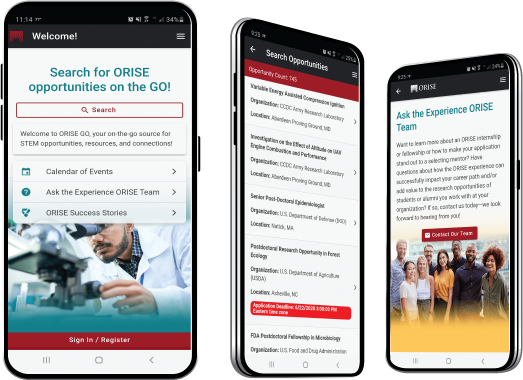Postdoctoral Fellowship in Harmful Algal Bloom Numerical Modeler
Connect with ORISE...on the GO! Download the new ORISE GO mobile app in the Apple App Store or Google Play Store to help you stay engaged, connected, and informed during your ORISE experience and beyond!
A complete application package consists of:
- An application
- Transcript(s) – For this opportunity, an unofficial transcript or copy of the student academic records printed by the applicant or by academic advisors from internal institution systems may be submitted. Selected candidate must provide proof of completion of the degree before the appointment can start. Click Here for detailed information about acceptable transcripts.
- A current resume/CV
- One educational or professional recommendation
All documents must be in English or include an official English translation.
*Applications will be reviewed on a rolling-basis.
NOAA Office/Lab and Location: Two research opportunities are currently available with the National Oceanic and Atmospheric Administration (NOAA), National Ocean Service (NOS), National Centers for Coastal Ocean Science (NCCOS), Stressor Detection and Impacts Division (SDI), Harmful Algal Bloom (HAB) Forecasting Branch located in Silver Spring, Maryland (may be eligible for telework).
The National Oceanic and Atmospheric Administration (NOAA) formed the National Centers for Coastal Ocean Science (NCCOS) in 1999 as the focal point for NOAA’s coastal ocean science efforts. NCCOS uses cutting-edge research and high-tech instrumentation to provide citizens, coastal managers, public health officials, and other decision makers with reliable information needed to determine how best to protect environmental resources and public health, preserve valued habitats, and improve the way communities interact with coastal ecosystems. The NCCOS is headquartered in Silver Spring, MD but also has research labs across the nation. The NCCOS also has many assets including research programs, vessels, satellites, science centers, laboratories, and a vast pool of distinguished scientists and experts.
The HAB-F Branch delivers near real-time forecasting products for predicting the intensity/severity, location, and the potential health risk HABs pose in the Great Lakes and coastal regions of the U.S. While national in scope, forecasting efforts and products address regional needs and specific HAB species. The product sets are intended to support coastal resource managers, public health officials, researchers, and the public.
Research Project: Specific projects include model development and validation for Lake Okeechobee, Alaska, and the Chesapeake Bay, among other regions as needed.
- Lake Okeechobee has been plagued with cyanobacteria blooms for decades. In the last few years, these blooms have had substantial impacts on the South Florida ecosystems (lake, estuaries, and Everglades) and economies, with significant public and political attention. We have been using satellite data to monitor these blooms for four years, and we are expanding our efforts to model and forecast the occurrence of these blooms.
- Alaska experiences annual blooms of the toxic dinoflagellate Alexandrium catenella, as well as other HAB species that can cause shellfish toxicity and vector toxins through the marine food web. There is a need for HAB forecasting products to help mitigate these blooms, but much of Alaska is lacking in environmental monitoring data to support a HAB forecasting effort.
- Numerous potentially toxic phytoplankton are known to bloom in the Chesapeake Bay and pose a threat to shellfish and fin fish, as well as public and ecological health. The diversity of HAB species and their unique impacts on fisheries, aquaculture, recreation, and/or drinking water, necessitates the development of novel multi-species HAB forecasts. The NCCOS has been using satellite data to monitor for blooms in the Bay for years to support management activities; we are expanding our efforts to model and forecast the occurrence of these blooms in the Chesapeake Bay region.
Specific research activities include: 1) evaluation of existing models (circulation, particle trajectory, etc.), 2) development of new models, 3) creation and analysis of satellite derived products for cyanobacteria and algal biomass, 4) integration of modeling products to produce HAB forecasts, 5) model validation using field data, and 6) communicating findings with stakeholders.
Learning Objectives: Under the guidance of a technical mentor, the selected candidate will gain experience in various research activities including ecological monitoring and modeling development and validation techniques, satellite data processing, historical data curation and calibration, data analytics, stakeholder engagement, as well as generating outreach materials and technical documentation.
Mentor: The mentors for this opportunity are Richard Stumpf (Richard.stumpf@noaa.gov), Michelle Tomlinson (michelle.tomlinson@noaa.gov) and Yizhen Li (yizhen.li@noaa.gov). If you have questions about the nature of the research please contact the mentor(s).
Anticipated Appointment Start Date: January 2022. Start date is flexible and will depend on a variety of factors.
Appointment Length: The appointment will initially be for one year, but may be renewed upon recommendation of NOAA and is contingent on the availability of funds.
Level of Participation: The appointment is full-time.
Participant Stipend: The participant will receive a monthly stipend of $6,000 and a health insurance supplement of $300 per month.
Citizenship Requirements: This opportunity is available to U.S. citizens and legal permanent residents (LPRs).
ORISE Information: This program, administered by ORAU through its contract with the U.S. Department of Energy (DOE) to manage the Oak Ridge Institute for Science and Education (ORISE), was established through an interagency agreement between DOE and NOAA. Participants do not become employees of NOAA, DOE or the program administrator, and there are no employment-related benefits. Proof of health insurance is required for participation in this program. Health insurance can be obtained through ORISE.
Questions: If you have questions about the application process please email NOAA@orau.org and include the reference code for this opportunity.
The qualified candidate should have received a doctoral degree in Oceanography, Aquatic Sciences, Marine Sciences, Limnology, Biological Sciences, or a related field.
Preferred skills:
- Research experience
- Demonstrated ability to work independently and part of a team
- Working knowledge of numerical models for open ocean and coastal systems.

 ORISE GO
ORISE GO

The ORISE GO mobile app helps you stay engaged, connected and informed during your ORISE experience – from application, to offer, through your appointment and even as an ORISE alum!





